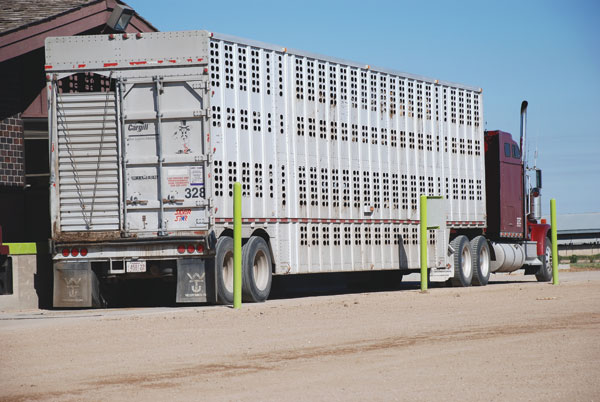Myths and facts about animal disease traceability
Here’s a common-sense look at the myths and facts surrounding cattle traceability from someone who’s been there.

“When they got Osama Bin Laden, they found a detailed plan of how to infect the United States cattle herd with anthrax. Do any of ya’ll have a little bit of hair standing up on the back of your neck? I’ve heard it, I’ve seen it and it gets me.”
That’s what Joe Leathers told the brand inspectors and other large animal law enforcement personnel who attended the International Livestock Identification Association annual meeting earlier this summer in Calgary, Alberta.
Leathers is general manager of the historic 6666 Ranch in Texas, Nevada, Wyoming and Montana. He started using EID tags on the ranch’s 12,000 cows almost 10 years ago and has seen the management benefits. But that’s just one ranch. He sees that animal disease traceability can benefit all beef producers.
Don’t jump to conclusions. Even though the Four Sixes is one of the large, iconic Texas ranches, Leathers understands small operations. After all, he was raised on a cotton farm where his dad ran 50 cows on land too rough to farm. He says while most babies had rattles and teething rings in their cradle, his dad gave him a hoe handle to wrap his fingers around.
Leathers ran through some myths and facts he’s uncovered in his involvement in the disease traceability debate. Here’s a look.
Fact #1: We have animal diseases. “BSE, TB, foot-and-mouth is a possibility, brucellosis, Asian longhorned ticks starting to show up. That’s a bad little bugger. We live in that time. That’s reality. We have diseases.”
Fact #2. The USDA and state vets are not our enemies. “I was asked by the [Texas} governor if I could be appointed as an animal health commissioner for the state. To be quite honest, I didn’t have a very good viewpoint of state vets. Sure didn’t have a good viewpoint of federal vets because I thought ‘all you’re gonna do is make regulations to keep me from doing my job,’” he said.
“Until I got in there. And I quickly realized these guys are here to protect my industry. And that is their sole purpose in life, to protect the animal industry in the United States.”
But the Animal Health Commission had a problem. “The major problem we have in Texas is the Animal Health Commission was developing much-needed rules and regs for some things, but they didn’t have near enough input from stakeholders, producers, and they got a lot of pushback from guess who? Producers. And I saw the same problem with the feds.
“We’ve got a problem with fever tick expansion, getting out of quarantines. And so my suggestion to the commission, to the state vets, let’s put together a council of producers from that region. They want to fix the problem, too. And they did. They started coming up with plans, framework being built by producers, and the opposition almost disappeared. And now we’ve done that with other aspects,” he told the group.
“So when you make producers partners, then the whole perception to the industry changes because they have a voice and they have representation.”
Fact #3. “Producers, us as ranchers, have needs at home and in our industry to protect our cattle but it’s got to fit into the way we work at home and it’s got to fit into our overhead because we don’t have a lot of overhead. But, in the same breath, our partners at the state level and federal level have needs too. They have needs to protect our herds from a disease outbreak and protect our foreign trade,” he said.
“You from the law enforcement sector have needs as well that fall in line with this. That’s another factor. And technology and science are valuable only if they effectively and efficiently work in the real world.”
“Here's another fact, and I'll put this fact in the form of a question. Why should I in Texas be penalized $300 a head in one day for one cow where they found BSE? Why is that? Because we couldn’t prove that the rest of the cows in the United States weren’t infected because we didn’t have (adequate disease traceability).
“Why should I, at the Sixes, be quarantined because another producer has something as simple as a fever tick if I’m not in the fever tick zone but they had moved a cow out of that zone up into our part of the country? Why should they quarantine a whole county when it’s just one cow? Because they can’t effectively and quickly trace it.”
Leathers said the beef business is looking at it from the wrong end. “We all want to look at profit. How many producers do you know who do risk management? How much does it cost? A bunch. It’s nothing more than an insurance policy that you pay into for risk management.”
Why do we not have a traceability program? “Fear. Perception. And this is not a bad word, so don’t throw stuff at me. Ignorance. We’re afraid of what we don’t know, we’re comfortable with the way Grandpa did it, we’re afraid it’s going to change our life. I don’t know how to work a computer. That doesn’t seem possible. That’s George Jetson and Star Wars. What’s it going to cost me, even though they have no idea. And we’re just a little bit hard-headed and independent. True. Fact.”
That said, Leathers moved into some myths surrounding disease traceability.
Myth #1. If we have an enhanced traceability program, there’s going to be a black helicopter flying around my house. If we have an enhanced traceability program, I’m going to incur more liability.
“How many people do you know who have a 911 address? You already have a premise ID,” he said.
“How many of you know that when you go to Walmart and you’re walking down the aisle looking at the products you want to buy, whether it be beef or clothes or whatever the case may be, they have a way of scanning your eyes and they know what you’re looking at and how many times you look at certain objects. How many know they can find you on your cell phone, ping you and find where you’re at just about any time they want to?
“We’re already there. I’ve had EIDs and been tracing my cattle since 2011 and haven’t seen a black helicopter yet.”
Regarding liability, Leathers said the fear is that we’re going to incur additional liability if we have an enhanced disease traceability program.
“I think that’s a myth. We already have liability. Are we going to incur more? No. You’ve already got it. Are we afraid of how we operate? I’m not. I think we do the very dadgum best we can and be as close to the cutting edge at the Sixes as we can.
“I know small producers, large producers all the way across these United States who have prolapsed pens. But their health management is as state of the art as it can be. They just don’t have the ability to build new pens. They make do with what they’ve got and there’s nothing to be ashamed of about that. So why are we worried about being sued for doing good job? Very hard to condemn excellence and we in the cattle industry are excellent and getting better every day.”
Myth #2. It’s nobody’s business. “We are an industry as a whole. And I’m going to be real blunt, we’re going to have to get over this selfish attitude that what goes on stays inside my fence. If you want to survive and you want your children and great grandchildren to survive in this industry, we better to go to thinking as an industry, unselfishly as a whole, and come up with a plan that’s going to benefit us in the future.”
Myth #3. I don’t believe we need to prove anything to anybody about how we operate. “I’m going to go back to reality and common sense. The American housewife wants to know her meat comes from. Wants to know where their vegetables come from. And if they can buy and know who raised it and knew how it was taken care of, whether you petted Ol’ Bessie every day or you had to catch her and drag her out of a cedar thicket, they want to know where their meat comes from. And if you could put essential oils and lavender on it and feed it to them, they’d buy it in a heartbeat because it’s all natural,” he joked.
“We laugh, but it’s true. My kids were raised on a ranch, they punched cattle when they were little. My daughters are into the all-natural and I tell them, honey, my grandparents, my mother and daddy and myself when I was young, we were all natural. We raised everything we had. The life expectancy of an adult was about 50 or 60 years old. We’re living to 80 or 90 now, so…balance that deal out a little bit.
“But we can sit back in our own little world, in our operations inside our fenceline and say it’s nobody’s business. And we can sit there and pretty soon we don’t have a business,” he said.
“What we do need to understand, it is time, long past due, to come together and to unify and to come up with a plan.”
About the Author(s)
You May Also Like



